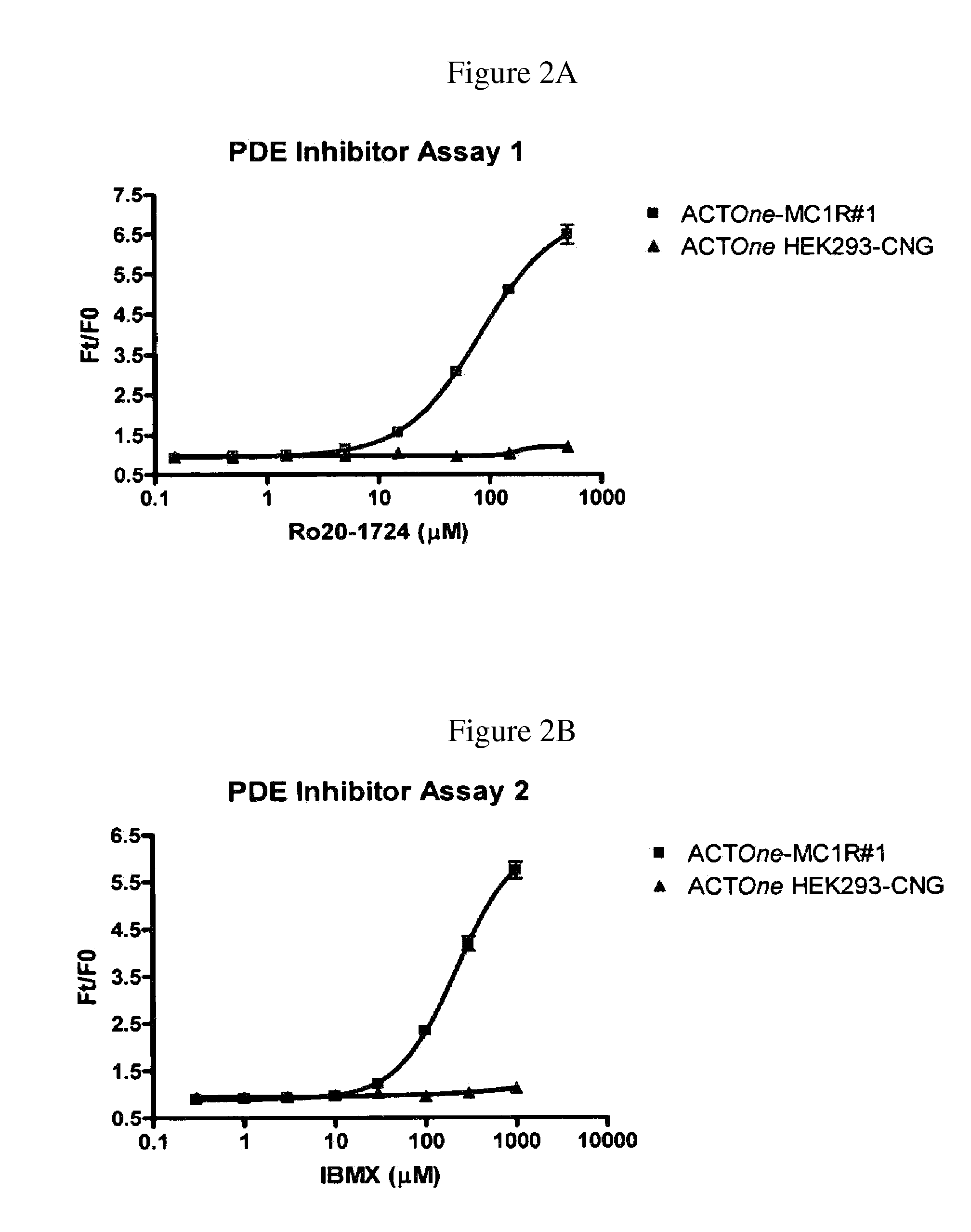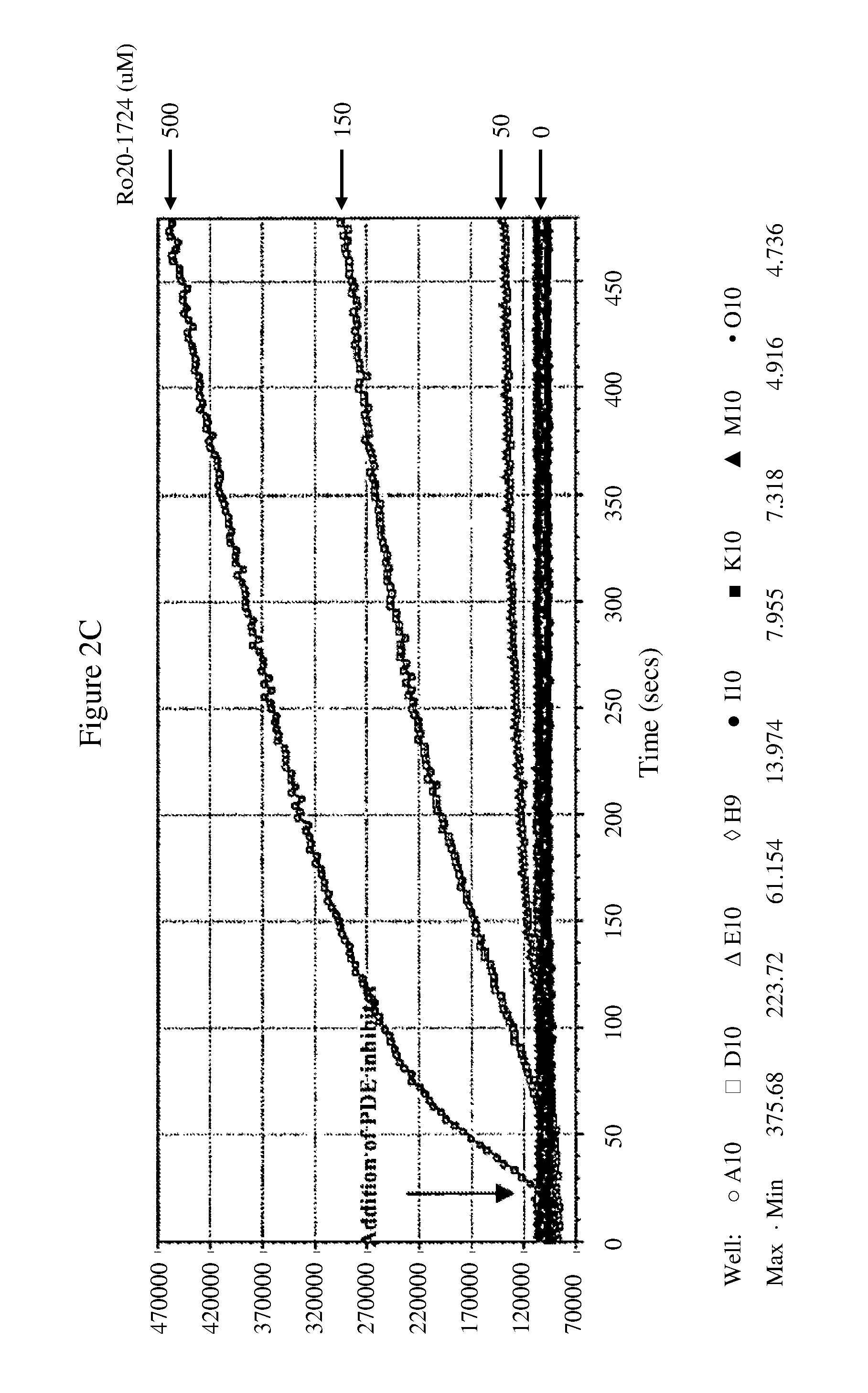Novel Cell-Based Phosphodiesterase Assays
a phosphodiesterase and cell-based technology, applied in the field of cell-based assays for measuring pde activity, can solve the problem that the activity of the basic level ac is not typically sufficient to allow detection
- Summary
- Abstract
- Description
- Claims
- Application Information
AI Technical Summary
Benefits of technology
Problems solved by technology
Method used
Image
Examples
example 1
Establishment of Stable Transfection Colonies for PDE Assay
[0144]Various mammalian cell culture systems can be employed to express recombinant protein. Examples of mammalian expression systems include the COS-7 lines of monkey kidney fibroblasts, described by Gluzman (Cell 23:175, 1981), and other cell lines capable of expressing a compatible vector, for example, the C127, 3T3, CHO, HeLa and BHK cell lines.
[0145]In this example, cell lines that stably express recombinant proteins were generated. Following the protocol recommended by InVitrogen Corporation (Carlsbad, Calif.), BD ACTOne™ HEK293-CNG cells (HEK293H cell stably expresses a mutant CNG channel, Cat # 341467, BD Biosciences, Rockville, Md.) were first split into 6-well plates with 70-80% confluence. For each well, the cells were transfected with 2 μg pCMV-A2b-IRES-PURO (plasmid for overexpressing human adenosine A2b receptor using CMV promoter) and 6.25 μl Lipofectamine 2000 (InVitrogen Corporation). About 18-22 hrs later, ...
example 2
Identification of Stable Cell Lines for PDE Assay
[0150]Transfection colonies obtained by approaches described in Example 1 can be screened by the following method to identify clones that are suitable for PDE assays. Stable clones with HEK293 background can be selected for PDE IV assays without introducing exogenous PDE IV gene, since PDE IV is the most abundant PDE isozyme in HEK293.
[0151]When cell density of colonies in 24-well plates (described in Example 1) reaches 60-80% confluence, remove culture medium and replace it with 1 ml of Dulbecco's Phosphate Buffers Saline without calcium and magnesium (DPBS). Remove DPBS and add 75 μl of 1× trypsin-EDTA to each well. Rock the plate to make sure the cells are equally covered with the solution. Incubate at room temperature for 5 min. Add 180 μl of growth medium (DMEM with 10% FBS, 250 μg / ml G418 and 1 μg / ml Puromycin) into each well. Suspend the cells well and plate 20 μl / well of cell suspension into a poly-D-lysine-coated 384-well ass...
example 3
Identification of Agents that Modulate PDE Activity
[0154]Compounds may be screened for their ability to function as agents for the modulation of PDE activity. A cell prepared according to the present invention may be contacted with a compound and PDE activity may be assayed. As an example, stable cell lines expressing a genes encoding a CNG channel protein and a GPCR of interest can be obtained (Ausuebl et al., Current Protocols in Molecular Biology, (2001) John Wiley & Sons) and from the example above. The GPCR gene is expressed exogenously.
[0155]Before the assay, all cells are harvested when they reach 80-90% confluence or less, and they should not be overgrown. Culture medium of the transfected cells was removed and replaced with a volume of Dulbecco's Phosphate Buffers Saline without calcium and magnesium (DPBS) to adequately cover and wash the cells. The DPBS was removed and a sufficient volume of 1× trypsin-EDTA was added to just cover the cells (i.e. 1 ml for a 10 cm dish, 2 ...
PUM
| Property | Measurement | Unit |
|---|---|---|
| volume | aaaaa | aaaaa |
| volume | aaaaa | aaaaa |
| volume | aaaaa | aaaaa |
Abstract
Description
Claims
Application Information
 Login to View More
Login to View More - R&D
- Intellectual Property
- Life Sciences
- Materials
- Tech Scout
- Unparalleled Data Quality
- Higher Quality Content
- 60% Fewer Hallucinations
Browse by: Latest US Patents, China's latest patents, Technical Efficacy Thesaurus, Application Domain, Technology Topic, Popular Technical Reports.
© 2025 PatSnap. All rights reserved.Legal|Privacy policy|Modern Slavery Act Transparency Statement|Sitemap|About US| Contact US: help@patsnap.com



